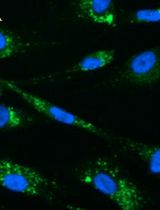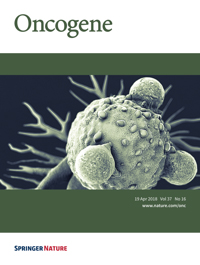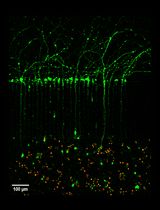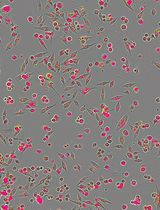- EN - English
- CN - 中文
Monitoring Natural Killer Cell Function in Human Ovarian Cancer Cells of Ascitic Fluid
在人卵巢腹水癌细胞中监测自然杀手细胞功能
发布: 2018年12月20日第8卷第24期 DOI: 10.21769/BioProtoc.3124 浏览次数: 6251
评审: HongLok LungAnonymous reviewer(s)

相关实验方案

利用Cyto-ID®染色和Cytation成像技术定量分析人类成纤维细胞中的自噬小体
Barbara Hochecker [...] Jörg Bergemann
2024年07月05日 1134 阅读
Abstract
Natural killer (NK) cells are the major effectors of the innate immune system when activated resulting in modulation of immune response of the host defense through target cell lysis and secretion of cytokines. Precise functions of NK cells are essential for the treatment outcome of different virus infections and malignant diseases. NK cells impart cytotoxic effect to the target cells lacking MHC class I molecules and thus the final readout of the activity is death of target cells. The NK cell function is evaluated by the 51Cr-release and/or flow cytometry-based assays. In the present protocol, we have determined the activation of NK cells by the liberation of IL-10 and IFNγ, and subsequently its function by enumerating the number of dead tumor cells originally isolated from the ascitic fluid of ovarian cancer patients. The entire assay is based on cells of the healthy donors and patients. Besides determining function, this method is able to demarcate between NK-cell sensitive and insensitive tumor cells. This technique enables researchers to study NK cell functions in healthy donors or in patients to reveal their impact on different malignancies and to further discover new therapeutic strategies.
Keywords: Ascitic fluid (腹水)Background
Being a part of innate immune system, natural killer (NK) cells involve in immune surveillance. They distinguish between healthy and abnormal cells (virus-infected or malignant) through a set of germline-encoded inhibitory and activating receptors (Marcus et al., 2014; Tognarelli et al., 2016). Under normal and healthy conditions, NK cells serve a role that is unlike other blood cells perform, until there is an infection. At that time natural killer cells assume their more recognized role in killing of targeted cells. NK cells exhibit direct cytotoxic effect via granzyme/perforin/death receptor pathways against the cells that lost the expression of HLA class I antigen (Geller and Miller, 2011; Paul and Lal, 2017). Further, NK cells are stimulated to produce IFNγ and TNF-α, which exert cytostatic/cytotoxic effects on specific targets. NK cell deficiency seems a part of larger immunological syndrome.
In general, the most common combination of surface markers used to identify the majority of NK cells is the absence of CD3, along with the expression of CD56 (i.e., CD3-CD56+). However, every NK cells of above phenotype may not be functionally active. It has been shown that Perforin and CD107a combination represent superior NK cells function (Rubin et al., 2017).
Several assays have been established for determination of the activity of NK and cytotoxic T cells, when they recognize the target cells. The 51Chromium release assay (CRA) was described for the first time (Brunner et al., 1968) to assay NK cells activity, which has been considered the ‘gold standard’ for measurement of cytotoxic effect. This assay indirectly determines dead cell population. Moreover, due to risks of handling and disposal of radioactive substance, several alternative methods have been developed time to time. Two fluorochromes based flow-cytometry assay is proposed for direct determination of dead target cells (Radosevic et al., 1990). In this case, fluorescently stained target cells, if lost viability, are counter stained with a DNA intercalating dye. Another fluorescence-based assay was proposed, which depends on the hydrolysis of Calcein AM (Lichtenfels et al., 1994) by intracellular esterases resulting in the formation of Calcein, a hydrophilic strongly fluorescent compound retained in the cytoplasm of the viable cells. In case of damaged ones, it releases in the medium producing an intense green signal measured by fluorimeter. The caveat of this assay is that the release calcein varies in its dynamic range for different tumor targets, and the calcein could retain within the apoptotic bodies and membrane fragments of the lysed cells results in incomplete release leading to underestimation. To overcome these limitations, a novel cytotoxicity assay using an image flow-cytometer was proposed, which is to be claimed as a simple and direct method (Srinivas et al., 2015). Later, two more assays based on LDH release (Konjevic et al., 1997) and bioluminescence (Karimi et al., 2014) have been proposed. While both of these methods provide indirect assessment, the former one is simple whereas the latter method is a complicated one. In this protocol, we have proposed a flow-cytometry based comprehensive method that not only provides direct value of percentage dead target cells but also analyzes sensitive cells in a heterogeneous population of ascitic or blood-derived cells. The earlier published methods were based on tumor cell lines, which is devoid of other cells present in the biological fluid in vivo. The scope of the present protocol is further extended to find out the efficacy of NK cells in cancer patients as compared to healthy persons. It is known that in cancer patients, depending upon the stages of the disease, the potency of NK cell immune surveillance is compromised (Levy et al., 2011). In an earlier paper, we discussed this protocol (Akhter et al., 2018), which clearly indicates that in ovarian cancer a subtype of tumor cells remains unaffected even in the presence of healthy donor NK cells. Thus, this protocol opens up the possibility to decide on a critical issue in NK cell immune therapy, that is how they should be generated for effective therapy.
Materials and Reagents
Note: The following materials were used to determine the activation and the function of NK cells.
- Pipette tips
- 10 ml Dispovan syringe (BD, catalog number: 301001)
- 10 ml Vacutainer Heparin Tube (BD, catalog number: 367880)
- Nylon mesh cell strainer 100 micron (BD, Pharmingen, catalog number: 352360)
- Nylon mesh cell strainer 40 micron (BD, Pharmingen, catalog number: 352340)
- 15 ml centrifuge tubes (BD, Pharmingen, catalog number: 352096)
- 50 ml centrifuge tubes (BD, Pharmingen, catalog number: 352070)
- 48-well cell culture cluster (Corning, catalog number: 3548)
- 75 cm2 cell culture flask (Corning, catalog number: 430720)
- 5 ml round bottom tube (BD, Pharmingen, catalog number: 352054)
- Ficoll-Hypaque, ρ= 1.077 g/ml (Sigma-Aldrich, catalog number: 10771)
- Phosphate-buffered saline (PBS) 1x (HiMedia Laboratories, catalog number: 023)
- Trypan blue solution (Sigma-Aldrich, catalog number: T8154)
- CD3/PE-Cy7 1:100 (BD, Pharmingen, catalog number: 563423)
- CD56/V450 1:200 (BD, Pharmingen, catalog number: 560360)
- CD45/APC 1:100 (BD, Pharmingen, catalog number: 555485)
- EpCAM antibody 1:50 (Abcam, catalog number: ab46714)
- HLA class I/FITC 1:100 (BD, Pharmingen, catalog number: 555555)
- HLA class II/FITC 1:100 (BD, Pharmingen, catalog number: 565558)
- RPMI-1640 medium (Thermo Fisher Scientific, catalog number: 11875093)
- ITS Liquid Media Supplement (100x) (Sigma-Aldrich, catalog number: 13146)
- Human Serum Albumin (HSA) 10 mg/ml (Sigma-Aldrich, catalog number: 12055-091)
- Epidermal Growth Factor (EGF) 20 mg/ml (Sigma-Aldrich, catalog number: E9644-2MG)
- IL10 ELISA kit (Pepro Tech Worldwide, catalog number: 900-K21)
- IFNγ ELISA (Pepro Tech Worldwide, catalog number: 900-K27)
- Propidium Iodide (PI) 5μg/100 ml (Sigma-Aldrich, catalog number: P4864-10ML)
- Citrate phosphate dextrose (CPD) 0.25 mM (Sigma-Aldrich, catalog number: C7165)
- 99.9% ethanol (Analytical CS Reagent, catalog number: 1170)
- Complete medium (see Recipes)
Equipment
- Pipettes
- Flow cytometer (FACSAriaIII, BD Sciences, San Jones, CA)
- ELISA reader (BioTEK, model: PowerWave Elite XS)
- CO2 incubator (NuAire, model: Nu4750)
- Refrigerated centrifuge (Eppendorf, model: 5810R)
- Biosafety cabinet (ESCO, model: Class II, Type A2)
- Inverted Microscope (Olympus, model: CK2)
- Hemacytometer (Sigma-Aldrich, catalog number: Z359629)
- Pipets 10 μl, 100 μl, 200 μl and 1,000 μl (Eppendorf)
- -80 °C Freezer (Thermo Scientific, model: FormaTM 900 Series)
- 4 °C Refrigerator (Whirlpool, model: FF-350 Elite)
Software
- BD FACSDivaTM Software (BD, Pharmingen, San Jones, CA) (has been used to analyze data of flow-cytometry based experiments)
- All statistical analyses are based on GraphPad Prism 5.01 (GraphPad Software, La Jolla, CA)
Procedure
文章信息
版权信息
© 2018 The Authors; exclusive licensee Bio-protocol LLC.
如何引用
Kumar, V. and Mukhopadhyay, A. (2018). Monitoring Natural Killer Cell Function in Human Ovarian Cancer Cells of Ascitic Fluid. Bio-protocol 8(24): e3124. DOI: 10.21769/BioProtoc.3124.
分类
免疫学 > 免疫细胞功能 > 细胞毒性
癌症生物学 > 细胞死亡 > 免疫学试验
细胞生物学 > 细胞活力 > 细胞死亡
您对这篇实验方法有问题吗?
在此处发布您的问题,我们将邀请本文作者来回答。同时,我们会将您的问题发布到Bio-protocol Exchange,以便寻求社区成员的帮助。
提问指南
+ 问题描述
写下详细的问题描述,包括所有有助于他人回答您问题的信息(例如实验过程、条件和相关图像等)。
Share
Bluesky
X
Copy link










